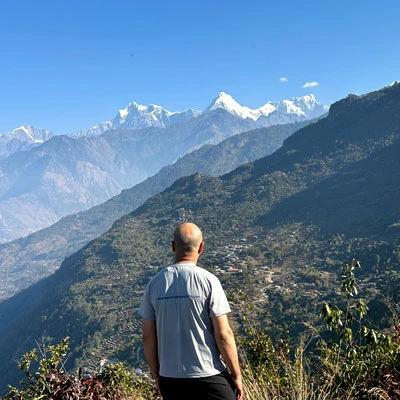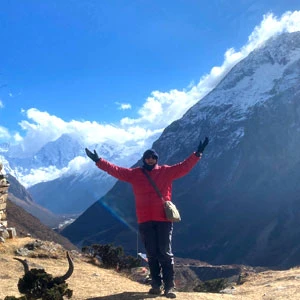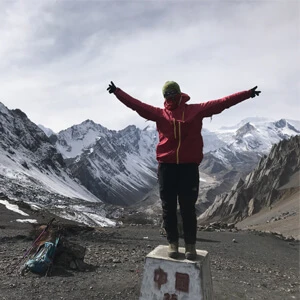Avoid Underestimating The Physical And Mental Challenges
One of the most crucial things to avoid during the Kanchenjunga Circuit Trek is underestimating the physical and mental challenges it presents. This trek spans three weeks or more, covering rough, high-altitude terrain. Additionally, the remoteness of the trail means you are venturing into isolated areas where help is far away, and rescue options are limited.
Therefore, this trek demands endurance, strength, and the ability to cope with not only physical fatigue but also the mental toughness to push through long days of hiking in often harsh conditions. Along the climb, the risk of altitude sickness is a real concern.
A lack of proper fitness can cause your body to struggle with these challenges, leaving you vulnerable to exhaustion, injury, or worse. Likewise, not being able to handle the isolation, difficult weather, and lack of amenities can take a huge toll on your mentality.
Altogether, it’s vital to begin your training 8 to 12 weeks before the trek. Your training regime should include building both cardiovascular endurance and strength. You should focus on long walks or hikes with a loaded backpack, and incorporate strength training for your legs, core, and back.
Similarly, you should practice mental resilience by pushing through longer treks and preparing for the mental obstacles you will encounter.
Avoid Trekking During Wrong Seasons
The timing of your Kanchenjunga Trek plays a significant role in ensuring both your safety and enjoyment. Each season brings a drastic change in the region’s conditions throughout the year. If you are planning for this trek, avoid the Monsoon (June to August) and Winter (December to February) seasons.
Monsoon is particularly hazardous for this trek. During these months, you will experience heavy rainfall that makes the trails slick and treacherous. This continued rain increases the risk of landslides and makes it nearly impossible to trek through certain sections.
You will also come across muddy and unstable trails, and rivers can swell, washing out paths and bridges. Lastly, the Monsoon brings out leeches, which can be a nuisance and a health risk, particularly if not properly managed.
On the other hand, the Winter months bring their own set of challenges. Although the region may look stunning with snow-capped peaks, the harsh winter conditions are far from ideal for trekking.
You will experience plummeting temperatures to dangerously cold levels, especially at higher altitudes. Due to such conditions, frostbite and hypothermia become real concerns. Moving on, snow and ice can also block important routes, making the trails difficult to navigate and, in some cases, impassable.
However, if you are searching for the best time to trek to Kanchenjunga Circuit, choose either Spring (March to May) or Autumn (September to November) for clear skies, stable weather, and more predictable conditions.
Avoid Trekking Without Proper Permits
When planning the Kanchenjunga Trek, ensure you have the proper permits. Unlike many other trekking regions in Nepal, the Kanchenjunga area falls under a Restricted Area, meaning you need to obtain special permits to enter.
Without these permits, you are at risk of being turned back at one of the numerous checkpoints along the way. At best, you will be stopped and forced to turn back; at worst, you could face legal consequences and hefty fines.
To avoid this, always arrange your permits through a registered local trekking agency like Nepal Trekking Experts that has experience with the Kanchenjunga region. Not only will they help you with the paperwork, but they will also ensure you meet all legal requirements.
Avoid Drinking Unpurified Water
Along the trails of the Kanchenjunga Circuit, you will encounter numerous water sources, but many of them may be contaminated. Streams, rivers, and waterfalls may look inviting, but they often carry harmful bacteria, parasites, or pollutants that can cause serious health issues, such as diarrhea or more severe waterborne diseases.
To stay safe and hydrated, you must always purify your water before drinking it. You can carry water purification tablets, filters, or a SteriPen to ensure that any water you collect is safe to consume. These tools are compact, easy to use, and highly effective at removing harmful pathogens.
In addition to health concerns, you should also avoid relying on plastic bottled water. While it might seem convenient, plastic bottles contribute significantly to the environmental pollution in the area. Likewise, buying a bottled water every time can be a huge expense. Instead, focus on reusable water bottles that you can refill and purify as needed.
Avoid Ignoring Altitude Sickness Symptoms
As you trek above 5,000 meters in this journey, the air becomes thinner, and your body struggles to adapt to the reduced oxygen levels. The high-altitude sections of the trek, especially around Kanchenjunga Base Camp and the northern trekking route, you will be exposed to the risks of altitude-related health issues.
Here, Altitude sickness can hit unexpectedly, and its symptoms can range from mild to severe. Initially, you will witness common signs such as headaches, nausea, dizziness, and shortness of breath.
If you begin to feel any of these symptoms, you must not ignore them. Also, if you push forward without giving your body time to acclimatize, it can lead to more serious complications, including high-altitude pulmonary edema (HAPE) or high-altitude cerebral edema (HACE), both of which can be life-threatening.
Hence, you must prioritize acclimatization by taking regular rest days at higher altitudes to allow your body to adjust. Likewise, you must also drink plenty of water to help your body adapt to the altitude. If you feel any symptoms of altitude sickness, do not hesitate to descend to a lower elevation, and seek medical assistance if needed.
Avoid Eating Unhygeinic or Unfamiliar Food
Given the Kanchenjunga region's remote nature, food hygiene can vary significantly between lodges and tea houses. In most places, you will find basic food preparations. While the local cuisine can be delicious and hearty, it is essential to be cautious about what you eat to avoid foodborne illnesses that could ruin your trek.
During the trek, you should avoid eating raw vegetables, dairy products from unknown sources, and undercooked meats. These items are more prone to contamination and can introduce harmful bacteria or parasites into your system.
Instead, you can opt for hot, freshly cooked meals, as cooking food at high temperatures helps kill any harmful pathogens. You can also stick to meals that you know are prepared in trusted tea houses. Some of the common and safe options include dal bhat (lentil soup with rice), momo (dumplings), and vegetable or chicken curries.
Avoid Littering And Disrespecting Local Customs
The Kanchenjunga region is incredibly fragile, with its pristine landscapes and diverse ecosystems that need to be preserved for future generations. Unfortunately, trekking in such remote areas can lead to pollution if you are not careful about your waste.
During the trek, you must follow the pack-in, pack-out principle: this means carrying out everything you bring in, including food wrappers, used tissues, and any non-biodegradable items. Likewise, you must showcase your respec towards the local culture.
The people who live in the Kanchenjunga region are proud of their heritage, and it is essential to approach their customs with respect. Always ask permission before taking photos, especially of people, as many locals view photography as a private matter.
Additionally, dress modestly when interacting with locals, particularly in villages and religious sites. Lastly, always follow cultural etiquette by being polite and participating in the local way of life in a humble and respectful manner.
Avoid Planning Solo Treks
To trek within the Kanchnejunga region, it is a mandatory rule to have at least two trekkers along with a licensed guide, since venturing alone in such a remote and rugged environment can expose you to significant risks. Even if trekking regulations ever change over time, solo trekking in the Kanchenjunga region is strongly discouraged due to the numerous dangers.
Altogether, you must hire a local guide. It not only fulfils the legal requirement but also serves as an invaluable resource for navigating the challenging terrain and understanding the local culture.
A knowledgeable guide can help you find the safest routes, manage altitude acclimatization, and offer insights into the environment and traditions of the area. Additionally, you should also consider hiring a porter to assist with carrying gear.
A single porter can carry up to 20 kg and can make your journey much more comfortable, allowing you to focus on the trek itself without the burden of heavy packs. Overall, trekking with a guide and a companion enhances the experience, as you will have someone to share the adventure with and learn from.
Avoid Overpacking or Underpacking
Both overpacking or underpacking can lead to unnecessary challenges that can make your trek more difficult and less enjoyable. Overpacking with excess weight will slow you down, increase fatigue, and put unnecessary strain on your body as you navigate the tough terrain.
On the other hand, underpacking leaves you vulnerable, especially in the remote areas of the trek, where resources are limited and you might be far from help. You may miss out critical items like a medical kit or rain gear which can turn a minor issue into a serious problem.
Therefore, to strike the right balance, your packing list for the Kanchenjunga Circuit should only include the essentials, ensuring your gear is lightweight yet functional.
Here’s a quick checklist of the must-haves for the trek.
Clothing layers for warmth, including a good insulating jacket and fleece.
Rain gear to protect from the unpredictable weather.
Basic medical kit with essentials like pain relievers, bandages, and altitude sickness tablets.
Power bank for charging devices.
Snacks like energy bars or trail mix to keep your energy up throughout the day.
Avoid Relying On Technology For Navigation And Communication
Since the Kanchenjunga Trek takes place within a remote area, you will have little to no connection during the trek. Even if you manage to get a signal, GPS apps can malfunction due to the lack of satellite connection or drain your phone's battery quickly, leaving you without any means of navigation when you need it most.
Therefore, relying on your licensed guide is crucial. A local guide knows the terrain intimately, understands potential hazards, and is skilled in reading both maps and natural markers, ensuring you stay on course throughout the trek.
On top of that, you can also carry physical maps and a compass as backup navigation tools. They can be particularly helpful when conditions are harsh or when you are venturing into unfamiliar areas.
Conclusion
As you prepare for the Kanchenjunga Circuit Trek, it is crucial to keep in mind the importance of avoiding these common mistakes. Trekking in a remote and challenging environment as Kanchenjunga requires careful planning, attention to safety, and respect for the local culture and nature. The above-mentioned 10 essential tips will help you avoid common pitfalls that could turn your adventure into unnecessary hardship.
To make this trek truly successful, you must partner with experienced professionals who know the terrain, the culture, and the challenges firsthand. Nepal Trekking Experts can help you plan every detail, arrange necessary permits, provide expert guides and porters, and ensure you have the best possible experience.
FAQs
Is solo trekking allowed on the Kanchenjunga Circuit?
No, solo trekking is not allowed. You need at least two trekkers plus a licensed guide to obtain the required permits.
What is the best season for the Kanchenjunga Circuit Trek?
Spring (March-May) and Autumn (September-November) are the best season for the Kanchenjunga Trek as they offer the best weather, clear skies, and stable trail conditions.
Do I need special permits for the Kanchenjunga Circuit?
Yes, you will need a Restricted Area Permit (RAP) and a conservation area permit, which you can only get through a registered trekking agency.
Is altitude sickness a big concern on this trek?
Yes, the trek reaches over 5,000 meters, hence, altitude sickness can be a real threat.
Should I hire a guide and porter for the Kanchenjunga Trek?
Absolutely. A licensed guide enhances safety, navigation, and cultural understanding, while a porter helps manage your gear, making the trek more comfortable.
How do I ensure safe drinking water on the trek?
You can use tablets, filters, or SteriPens to purify the water from teh natural sources. Also, it is best to avoid buying plastic bottled water to reduce environmental impact.







